You can’t get away from the sheer volume of articles on LinkedIn, popular media sites, and even here on ‘Buy the Way’ about how to reach the millennial market; and now a sub-segment called Xennials that claim to own a six-year birthright claim on ‘gee it feels different to identify with groups that only knew about iTunes). With every article, I see respondents from GenX claiming that they also feel like technology has been a growing and current part of their lives too. Eventually someone will say that its people, not just millennials.
This made me very curious so I dove deep into a variety of market research about “the people” that developed and use technology today – and this spans across four marketing generations. I started to see a pattern in the research of overlapping attitudes, values, behaviors, and technographics that didn’t make much sense. How do you properly segment these generations (mostly millennials and GenX) if they claim to have the same purchasing patterns? There are some obvious points of demographics that one can group people into (such as parents, age, attending university, retired, male, female, geography) but the technology usage and behaviors were overlapping. I then started to see the small but unique differences in the ranking of channel preferences and the delivery methods of offers that if you pay close attention to, you can truly deliver the right offers to the right audience over the right channel – and yet market your umbrella brand in a way that will capture emotion and interest across multiple generations with the same behaviors.
After jotting down the similarities and slight differences, I found an article from Raymond Morin in Currati (2016) describing the “connected consumer” and the green light went on. There is a common set of behaviors that brands must understand how to market to, in order to capture attention, build relationships with customers, and be considered for current and future purchases. Morin writes that people have lost trust in brands since the recession and that they want greater transparency from them.
Connected consumers prefer non-intrusive ads, flock to user-generated content, prefer personalization, and can sniff out fake content (Morin, 2016). Hey doesn’t that sound like anyone using wifi these days? Don’t we all want to be treated better by brands based on our past experiences? Does your day get turned around based on whether or not you have wifi access? If so, you might be in the connected consumer generation (with your own set of preferences around that).
When I thought about analog-to-digital memories and applications, I realized that the digital evolution timeframe had a roadmap track that ran across the millennial, GenX, and baby boomer generation. For example, in the years 1996-2000, a baby boomer was managing a GenX worker, and parenting a young millennial while music was transitioning to the web, and the web was transitioning to mobile. All three people in this generation experience a shift in the way they used technology.
If you adopted technology in the workplace, you likely kept up with it or helped to develop it along the way. Therefore by owning these devices and changing behaviors all three consumers have related technology attitudes and behaviors. Now the way they use them are often very different (i.e. from email vs. apps, to how many apps you use, and how patient you are with getting access to the information you need). Josh Perlstein from CMO.com presents three ways to separate the way you market to GenX and millennials: by channel, by content, and by conversion (Perlstein, 2017)
In order to illustrate this point for marketers, I’ve attached an example I created of a common set of purchasing behaviors across millennials and GenX with variations in the ranking of channels used and preferences within those channels.
Please share your thoughts and comments about bridging the generational gap of tech-savvy people with the term “connected consumers”.
References:
Ann, J. (2016, March 14). 5 effective ways to reach millennials. Marketing Insider Group. Retrieved from: https://marketinginsidergroup.com/content-marketing/5-effective-ways-to-reach-millennials/
D’Souza, J. (2017, June 28). Xennials, The Microgeneration Between Gen X And Millennials. Huffington Post. Retrieved from http://www.huffingtonpost.ca/2017/06/28/xennials_a_23006562/
Fromm, J., & Huff, S. (2017). Millennials wants deals not discounts. Millennial marketing by FutureCast. Retrieved from: http://www.millennialmarketing.com/2010/08/millennials-want-deals-not-discounts/
Goldman Sachs (n.d., 2016). Data Story: Millennials. Goldman Sachs. Retrieved from: http://www.goldmansachs.com/our-thinking/pages/millennials/
Google.com (2017). Think with Google. Google. Retrieved from: www.thinkwithgoogle.com
Loechner, J. (2017, March 16). Millennials follow brands Gen X follows contests. Mediapost.com. https://www.mediapost.com/publications/article/296926/millennials-follow-brands-genx-contests-and-bo.html
Morati, R. (2016, Dec 1). Connect consumer trends. Curatti. Retrieved from: https://curatti.com/connected-consumer-trends/
Perlstein, J. (2017). The three C’s of marketing. CMO.com. Retrieved from: http://www.cmo.com/opinion/articles/2017/3/7/the-three-cs-of-marketing-to-gen-xers-vs-millennials.html#gs.ymD342A
Spenner, P. (2014, April 16). Inside the millennial do’s and don’t’s of marketing to this powerful generation. Forbes. https://www.forbes.com/sites/patrickspenner/2014/04/16/inside-the-millennial-mind-the-dos-donts-of-marketing-to-this-powerful-generation-3/2/#16d08e93523f
US Department of Labor Data (2016). Spending habits by generation. US Department of Labor. Retrieved from: https://blog.dol.gov/2016/11/03/spending-habits-by-generation

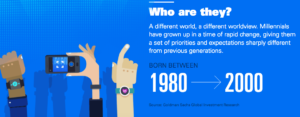

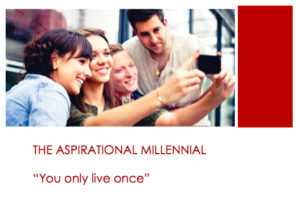
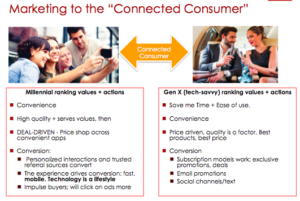
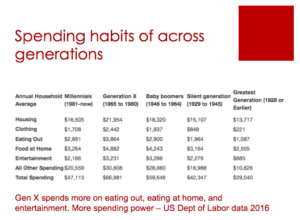
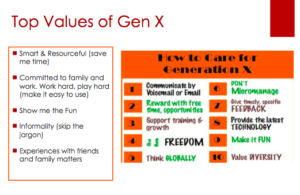
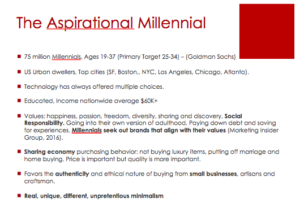
One Response to Marketing to the Connected Consumer